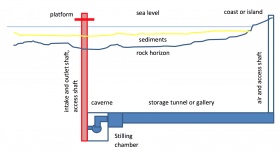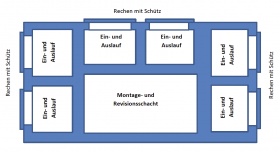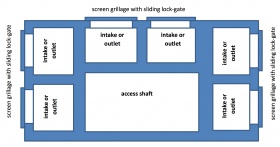
PSW Offshore
Pumped-Storage of Hydroelectricity
The pumped-storage hydroelectric plant uses the hydrostatic water pressure at sea levels off Scotland or the Irish Sea at a depth of 500 m. The plant could be fed from excess electricity generated by off-shore or, depending on the grid connection point and where available on-shore wind farms. A typical plant will have the following structure:
- air, inspection and access pit coast side (initial vertical cavity)
- storage tunnel or gallery below sea level in a solid geological layer (cretaceous, marl or chalk)
- intake, outlet, air, inspection and access shaft in the sea near off-shore wind farms (vertical cavity at the outer end of the cavern)
- cavern for electric generating equipment (turbine) below the intake and outlet pits (this will also serve as the turning basin for the tunnel drilling equipment during cavern construction)
- one or more horizontal cavern for water flooding in during generation or pumped empty during charging operations
- discharge closure devices
- hydroelectric generating set with pump turbine, generator und electrical connection plant
The storage will be provided by separate caverns (tunnels) dug in a solid geological layer deep under the sea bed. The (typically) twin tunnels will be drilled at a depth of 400 to 500 m. The tunnels will have a diameter of 12 to 15 m. The tunnel drilling machine will be taken through the inspection and access shaft coast side. The tunnel drilling machine will be used to dig the tunnels over a length of approx. 50 km below the off-shore wind farms. The turning cavern for the drilling equipment will be built at the end of the storage tunnels sea side. This cavern will later house the electricity generating equipment, the room for the electrical
connection plant and the stilling basin below the intake, outlet, air, inspection and access shaft.
The intake, outlet, air, inspection and access shaft sea side will be built in parallel with drilling the coast side shaft using a pressurised caisson for deep-sea work. After the completion the PSH plant, sea water will be allowed into storage tunnels through the inlet shaft and passes through the electricity generating turbines, filling the storage tunnels. The pressurised air is discharged through the coast side air shaft. At times of excess wind capacity, the turbines work in reverse and pump out the storage tunnels again taking in air from the coast side air shafts. As an example, the supply shaft on someone of the german island (in the North
Sea off Germany) is used for air in and outlet. Furthermore, a factory workshop is built on top of the coast side shaft which contains a crane for supply of equipment to the turbine hall. The coast side shaft is separated from the storage tunnels by an air-tight access hatch. The storage tunnels off the island will also be used as HV cable routes for connection of the off-shore wind farm. It will only be necessary to lay undersea cables from the island to the shore.


